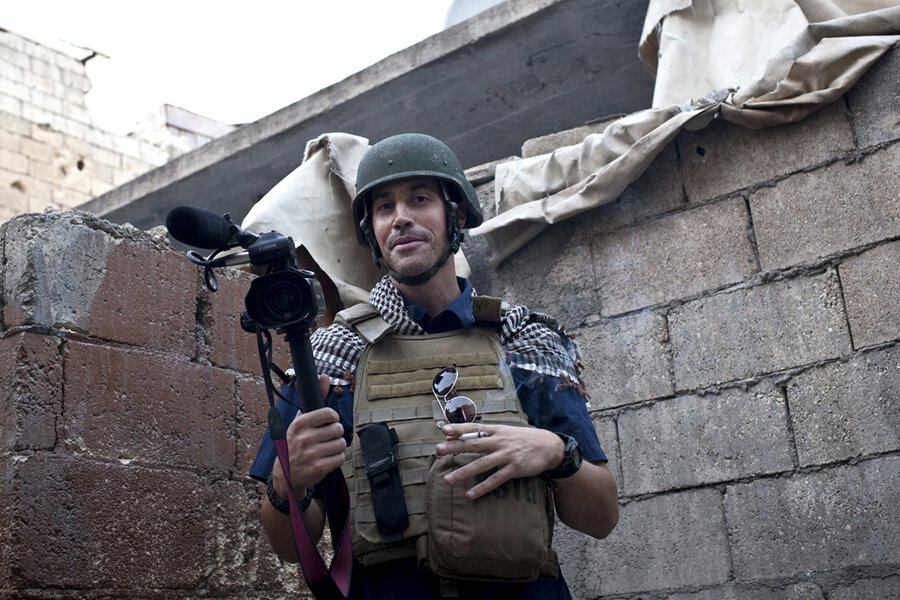James Foley's murder puts spotlight on journalists in conflict zones
Loading...
The video-recorded execution of kidnapped American freelance journalist James Foley and threat to kill another freelancer, Steven Sotloff, by the self-proclaimed Islamic State (IS) militant group is raising questions about the safety of journalists, particularly freelancers, who go into conflict situations to report.
The video showing Mr. Foley's murder was released on Tuesday afternoon by IS. But Foley disappeared in Syria almost two years ago, on Nov. 22, 2012. At the time, he was reporting for GlobalPost and Agence France-Presse on the war in Syria and the fight against the regime of President Bashar al-Assad.
Mr. Sotloff appears at the end of the video, as an IS fighter says, “The life of this American citizen, Obama, depends on your next decision.” Sotloff has reported from several countries in the Middle East for different publications. The Christian Science Monitor published three pieces from him between 2010 and 2012.
It is unknown how many other journalists IS is currently holding. But Foley's murder and the threat to Sotloff underscore the danger of reporting in conflict zones. They also focus fresh attention on the relationship between media outlets and the freelance journalists who choose to work in such dangerous situations.
Here are three questions about the current state of affairs in the industry.
Which country is currently the most dangerous for journalists to work in?
The Committee to Protect Journalists has tracked 1,070 journalist fatalities since 1992. So far in 2014, CPJ says, Syria has been the deadliest country for reporters. Five journalists, not including Foley, have been killed there this year.
In addition, approximately 20 journalists are currently missing in Syria, with IS holding some of those journalists. CPJ ranks Syria as "the most dangerous country for journalists; at least 69 others have been killed covering the conflict, including some who died over the border. More than 80 have been kidnapped."
Reporters Without Borders, another group that tracks conditions for reporters, agrees that Syria is "the world’s most dangerous country for journalists." Last year the group published a report titled “Journalism in Syria, Impossible Job?” that examined the difficult conditions there for both foreign and domestic journalists.
This is not a new phenomenon: Syria has topped the list for the past two years. According to CPJ, 28 reporters were killed in Syria in 2013, and 31 reporters in 2012. Also, one media support staffer was killed in 2012.
CPJ adds that seven more journalists were killed in Syria in 2012 and 2013, but for unknown motives – their deaths may not have been related to their work.
Many freelance journalists, like Foley, were among those killed.
How may journalists have died in the line of work?
CPJ reports that so far in 2014, 30 journalists have been killed around the world while on the job. Besides Syria, four journalists each have been killed so far this year in Ukraine, Iraq, Israel, and the Palestinian Territories, reflecting ongoing conflicts in those regions.
Overall, Iraq, the Philippines, and Syria are the top three deadliest countries for journalists to work in.
What is the relationship between news organizations and freelance reporters?
There is no simple answer to this question. Individual news outlets make their own choices when considering work from freelancers – including what, if any, hostile environment training they require reporters and photographers to have.
The Monitor's policy requires that writers have hostile environment training as well as experience reporting from conflict zones. Only staff writers or journalists with longstanding ties to the Monitor or substantial relevant experience are permitted to contribute from active war zones. This policy governed Monitor assignments in Syria. The paper stopped sending reporters in as of May 2013, due to intensifying risks to personal safety.
Writing in the Columbia Journalism Review last year, Richard Pendry noted that a contradictory relationship has emerged between media outlets and freelance reporters and photographers over the conflict in Syria.
Today’s news editors rely on freelancers more than ever because they have too few staff reporters, and those that are still employed may be reluctant to risk their lives. For these reasons, Syria is sometimes called the “freelancer’s war.” …
But even as outlets rely increasingly on freelancers for foreign coverage, they are making statements against using them in warzones.
Freelancers are often left with the responsibility for their own insurance and potential medical fees. The high cost of safely reporting from war zones and the low pay for pieces also entered the spotlight when freelance journalist Francesca Borri detailed her own experience reporting in Syria.
In recent years, groups have formed to aid freelancers in the field – doing everything from providing support and assistance to offering medical and first aid training to helping them organize and voice concerns.
The Monitor dealt with the kidnapping of a freelance reporter on assignment for the publication in 2006. She was released after three months.








